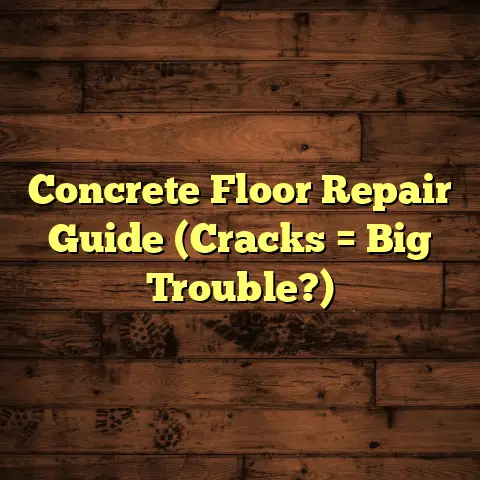Laminate With Moisture Barrier: Does It Really Work? (Explained)
“Water, like a good friend, can be a great help or a terrible burden.” This quote from an old flooring expert resonates strongly with me, especially when considering laminate flooring with a moisture barrier. I’ve spent years navigating the ups and downs of various flooring installations, and moisture is one of the biggest challenges I’ve faced.
When I first started as a flooring contractor, I quickly learned that not all flooring materials are created equal. The first time I encountered an issue with moisture was during a job in a basement. The homeowner wanted to install laminate but was concerned about potential water damage. At that moment, I realized the importance of choosing the right materials for the job.
The Basics of Laminate with Moisture Barrier
When we talk about laminate flooring, we’re often drawn to its affordability and variety. But in humid environments, the risk of water damage looms large. That’s where moisture barriers come in. They act as a protective layer, preventing moisture from seeping into the laminate.
What Exactly Is Laminate Flooring?
While laminate flooring might seem straightforward, it’s more than just a pretty surface. It’s constructed from multiple layers, including a wear layer, design layer, core layer, and backing layer. The core layer is usually made from high-density fiberboard (HDF), which gives it strength and durability. However, this material is susceptible to moisture, which is why incorporating a moisture barrier is crucial.
I remember one job I did in a coastal town where humidity was a constant issue. The homeowner was concerned about installing laminate in their kitchen. After discussing the options, we opted for laminate with a built-in moisture barrier. It was a game-changer, providing peace of mind without sacrificing style.
My Experience with Moisture Barriers
Success Story: The Coastal Kitchen
The installation went smoothly. I used FloorTally to estimate costs accurately and track materials. It helped me pull local rates for labor and materials. The client appreciated the transparency, which fostered trust.
The moisture barrier installation itself took about two days, and I had to ensure that the subfloor was level and clean. Using the right underlayment was crucial to maximizing the effectiveness of the moisture barrier. I chose a foam underlayment specifically designed for laminate floors.
After installation, the homeowner noted how comfortable it felt underfoot. The barrier worked wonders during a particularly rainy season, as there were no signs of warping or damage.
Challenge: The Bathroom Mishap
Not every project has gone as smoothly. I once installed laminate in a bathroom without considering the potential for water exposure. I thought the moisture barrier would suffice, but I underestimated how much splashing could occur around the sink and tub.
Within weeks, I noticed some bubbling along the edges. It was a tough lesson learned about the importance of proper sealing and maintenance in high-moisture areas. I had to replace sections of the flooring and ensure proper caulking around fixtures to prevent future issues.
This experience led me to understand that even with a moisture barrier, proper installation techniques and maintenance are essential. For any future projects involving bathrooms or kitchens, I became more diligent in discussing potential water exposure with clients.
Comparing Options: Moisture Barrier vs. Standard Laminate
Let’s break down my experiences with both types:
- Moisture Barrier Laminate: This type includes a built-in moisture barrier or requires an additional layer during installation. I find this option ideal for kitchens, bathrooms, and basements—areas prone to spills or humidity.
- Standard Laminate: While more budget-friendly upfront, I’ve encountered problems in moisture-heavy environments. If you choose this option, be prepared for potential repairs or replacements.
The cost difference can be significant. For example, moisture barrier laminate can run about $2.50 to $5 per square foot, while standard laminate might cost around $1 to $3 per square foot. However, in the long run, investing in moisture protection can save money on repairs.
Case Study: Kitchen vs. Bathroom Installation
To illustrate the differences further, let’s consider a side-by-side comparison of two installations—one in a kitchen and another in a bathroom.
Kitchen Installation:
- Location: Coastal home kitchen
- Type: Moisture barrier laminate
- Cost: $4 per square foot (including installation)
- Outcome: Successful installation; no issues reported after six months.
Bathroom Installation:
- Location: Suburban home bathroom
- Type: Standard laminate
- Cost: $2 per square foot (including installation)
- Outcome: Damage occurred within weeks due to splashes; costly repairs needed.
This comparison illustrates how choosing the right type of laminate based on location can significantly impact long-term satisfaction and costs.
Tips for Installation and Maintenance
Installation Insights
- Choose Quality Materials: Always opt for high-quality laminate with a reliable moisture barrier. I’ve seen cheaper options fail quickly under moisture stress.
- Proper Underlayment: Investing in the right underlayment can enhance performance significantly. Foam or cork underlayments with moisture protection are best.
- Seal Edges: Pay attention to areas around sinks and tubs. Using caulk helps prevent water from seeping through seams.
- Acclimate Your Flooring: Let your laminate acclimate in the room for at least 48 hours before installation to minimize expansion.
Maintenance Tips
- Regular Cleaning: Keep surfaces dry; use a damp mop instead of soaking wet mops to avoid excess moisture.
- Immediate Spill Cleanup: Don’t let spills sit—clean them up right away to prevent damage.
- Humidity Control: Consider using dehumidifiers in areas prone to high humidity.
Technical Specifications and Manufacturing Processes
Moisture barrier laminates are made through a multi-layer process:
- Core Layer: Typically made from high-density fiberboard (HDF), providing durability.
- Moisture Barrier Layer: This could be a film or specially treated surface that prevents water intrusion.
- Decorative Layer: A printed design gives it the aesthetic appeal, mimicking wood or tile.
- Wear Layer: This top layer protects against scratches and fading.
Manufacturers vary in their processes, so understanding how each brand constructs its product can help guide decisions.
Understanding Manufacturing Processes
During my time in the industry, I’ve visited several manufacturing plants to see how laminate flooring is produced. Here’s a brief overview of what I learned during those visits:
- Material Selection: High-quality raw materials are essential for good laminate flooring. Manufacturers often source HDF from sustainable forests.
- Pressing Process: Once the layers are assembled, they undergo high-pressure pressing to bond them together effectively.
- Finishing Touches: After pressing, the boards are cooled and trimmed to size before being packaged for shipment.
Understanding these processes has helped me appreciate why some products cost more than others and why investing in reputable brands can lead to better long-term results.
Environmental Considerations
As climate awareness grows, many homeowners are becoming more conscious of their flooring choices’ environmental impact. Fortunately, moisture barrier laminates have made strides in this area as well.
Eco-Friendly Options
Many manufacturers now offer eco-friendly laminate options that use sustainable materials and low-VOC (volatile organic compounds) adhesives. When selecting products for clients, I make it a point to inquire about their environmental policies.
In one recent project for an environmentally conscious couple, we managed to source laminate with FSC (Forest Stewardship Council) certification and a moisture barrier that met their sustainability goals. They were thrilled to have beautiful flooring that aligned with their values!
Cost Estimation and Budgeting with FloorTally
When it comes to budgeting for flooring projects, accuracy is key. FloorTally has been instrumental in helping me create realistic budgets while keeping my clients informed every step of the way.
How FloorTally Helps Me
- Accurate Cost Estimates: One of the first things I noticed when I started using FloorTally was how accurate the cost estimates are. The platform pulls local material and labor rates, which means I can provide clients with realistic budgets right from the start.
- Comprehensive Project Planning: I often work on multiple rooms at once, and FloorTally makes it simple to input various area types without missing any details.
- Visualizing Costs: FloorTally’s visualization tools help clients understand how their choices affect the overall budget. This visual representation leads to better discussions and ensures everyone is on the same page before moving forward.
- Guiding Clients on Choices: Thanks to FloorTally’s detailed input options, I can guide my clients in making informed choices that align with their budget and aesthetic preferences.
- Effective Waste Management: I always prepare for waste, but FloorTally takes it to another level by incorporating a waste factor into calculations, minimizing unexpected costs during projects.
Actionable Tips for Homeowners
It’s one thing to understand how laminate with a moisture barrier works; it’s another to put that knowledge into action! Here are some tips for homeowners considering this flooring option:
- Assess Your Environment: Before making any decisions, evaluate your home’s moisture levels—especially if you live near water sources or have experienced flooding in the past.
- Consult Professionals: Don’t hesitate to reach out to flooring professionals for advice tailored to your specific situation.
- Don’t Skimp on Quality: While it may be tempting to go for cheaper options, investing in quality materials will pay off in durability and aesthetics over time.
- Stay Informed About Maintenance: Familiarize yourself with proper cleaning techniques and regularly check for signs of water damage—early detection is crucial!
- Consider Your Lifestyle: If you have children or pets, think about how your choice of flooring will hold up against daily wear and tear alongside moisture exposure.
Common Misconceptions About Laminate Flooring
Over the years, I’ve encountered several misconceptions regarding laminate flooring that I’d like to address:
- Laminate Isn’t Durable: Many believe laminate is fragile; however, high-quality products come equipped with wear layers that offer impressive durability against scratches and dents.
- Moisture Barriers Are Unnecessary: Some homeowners assume that all laminate is waterproof or doesn’t need additional protection; this belief can lead to costly mistakes down the line.
- Installation Is Simple Enough for DIYers: While some homeowners may feel confident about DIY installations, improper handling can lead to significant issues—especially regarding moisture barriers!
- All Laminate Looks Fake: Advances in technology have allowed manufacturers to produce laminate that closely resembles natural wood and stone without sacrificing quality or performance.
By addressing these misconceptions head-on through education and clear communication with clients, I’ve been able to build trust while guiding them toward informed decisions regarding their flooring needs.
Final Thoughts on Moisture Barrier Laminate
After years of working with various flooring types, I firmly believe that laminate with a moisture barrier is worth considering if you’re in a humid environment or prone to spills.
While it may come at a higher initial cost compared to standard laminate, the peace of mind it offers is invaluable. Plus, with accurate estimates from FloorTally, budgeting becomes less daunting.
Ultimately, investing in quality materials and proper installation pays off in durability and performance. If you’re pondering whether to go for that moisture barrier option, think about your specific needs and environment—it could save you hassle and money down the road!
I hope this discussion has provided valuable insights into laminate flooring with moisture barriers! If you have any questions or want to share your experiences, feel free to reach out!





